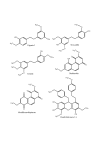Dendrobium: Sources of Active Ingredients to Treat Age-Related Pathologies
- PMID: 29344419
- PMCID: PMC5758354
- DOI: 10.14336/AD.2017.0214
Dendrobium: Sources of Active Ingredients to Treat Age-Related Pathologies
Abstract
Dendrobium represents one of the most important orchid genera, ornamentally and medicinally. Dendrobiums are sympodial epiphytic plants, which is a name they are worthy of, the name coming from Greek origin: "dendros", tree, and "bios", life. Dendrobium species have been used for a thousand years as first-rate herbs in traditional Chinese medicine (TCM). They are source of tonic, astringent, analgesic, antipyretic, and anti-inflammatory substances, and have been traditionally used as medicinal herbs in the treatment of a variety of disorders, such as, nourishing the stomach, enhancing production of body fluids or nourishing Yin. The Chinese consider Dendrobium as one of the fifty fundamental herbs used to treat all kinds of ailments and use Dendrobium tonic for longevity. This review is focused on main research conducted during the last decade (2006-2016) on Dendrobium plants and their constituents, which have been subjected to investigations of their pharmacological effects involving anticancer, anti-diabetic, neuroprotective and immunomodulating activities, to report their undeniable potential for treating age-related pathologies.
Keywords: Dendrobium; aging; anti-diabetic; anticancer; immunomodulatory; neuroprotective.
Figures
References
-
- Xu J, Han QB, Li SL, Chen XJ, Wang XN, Zhao ZZ, et al. (2013). Chemistry, bioactivity and quality control of Dendrobium, a commonly used tonic herb in traditional Chinese medicine. Phytochem Rev, 12: 341-367
-
- Ng TB, Liu J, Wong JH, Ye X, Wing Sze SC, Tong Y, et al. (2012). Review of research on Dendrobium, a prized folk medicine. Appl Microbiol Biotechnol, 93: 1795-1803 - PubMed
-
- da Silva JA, Cardoso JC, Dobranszki J, Zeng S (2015). Dendrobium micropropagation: a review. Plant Cell Rep, 34: 671-704 - PubMed
-
- Lin Y, Wang F, Yang LJ, Chun Z, Bao JK, Zhang GL (2013). Anti-inflammatory phenanthrene derivatives from stems of Dendrobium denneanum. Phytochemistry, 95: 242-251 - PubMed
Publication types
LinkOut - more resources
Full Text Sources
Other Literature Sources


